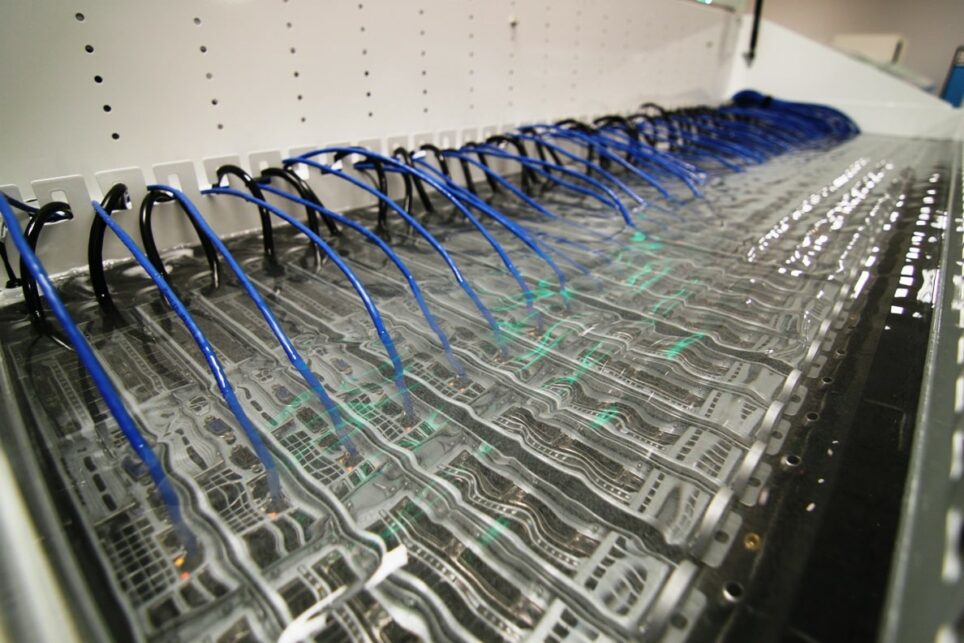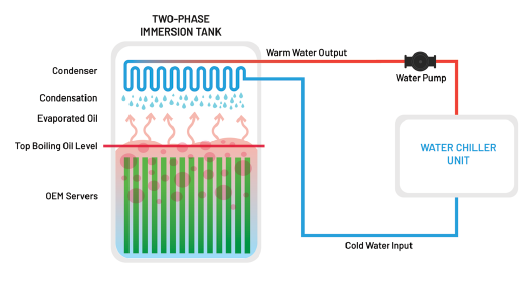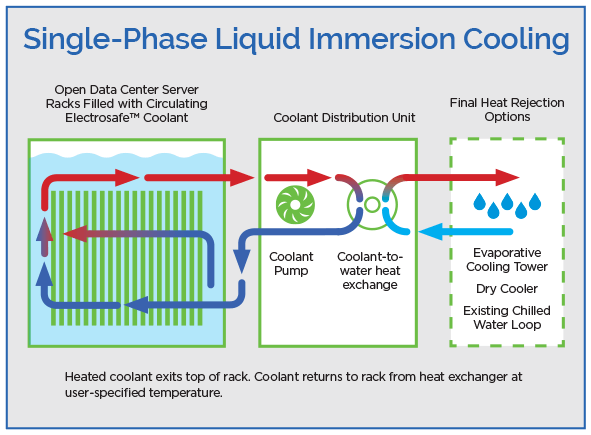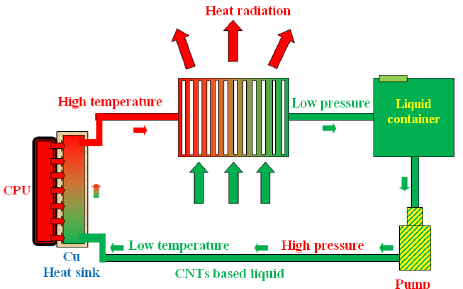In this article, we will take a look at the evolution of data center cooling. We will consider the two main cooling designs employed in data centers, highlighting the more advanced design of liquid cooling.

The Challenge of Data Center Cooling
Cooling is a vital part of data centers. In the past, operators paid little attention to the energy consumption of cooling systems. Operators simply thought that “the cooler, the better.” But they have come to realize that cooling systems consume vast amounts of energy. Power Usage Effectiveness (PUE) made operators think twice about their cooling system.
Today, energy consumption is one of the biggest concerns in the data center industry. Since the past decade, the industry has been focusing on reducing data center PUE. The challenge is to have optimal cooling with less energy consumption. This reduces the CO2 footprint of the data center, as well as reduces operational expenses.
The rising volumes of data are the driver of the increasing data center demand. Data centers consume vast amounts of energy. In 2016, these facilities consumed 416.2 terawatt/hours of energy. This accounts for 3% of the total global energy consumption. It is expected to double every four years.
Air Cooling vs Liquid Cooling
There are two main types of cooling designs employed in data centers. First is air cooling, which has always been used in data centers. And secondly, liquid cooling is the most recent technology for cooling servers.
As the name suggests, it utilizes cold air which is delivered to server racks. The heat is dissipated by exchanging warmer air with cooler air. Although widely employed in data centers, air cooling poses several disadvantages.
It cannot keep up with the increasing high density server racks. Higher server densities require more fans for higher volume airflow, colder air and is inefficient. Not to mention moving that volume of air is noisy and disruptive to workers in the data center hall.
More importantly, the air is not an effective heat transfer medium. With the increasing demand, data centers simply need more efficient cooling methods. Air cooling can be cheaper to install but it’s inefficiencies and capabilities for high density computing and removing heavy heat loads makes it a poor choice for some modern data centers.
Instead of air, dielectric liquids transfer and remove heat from IT equipment. Some data centers are employing liquid cooling as it is more efficient as a heat transfer medium. A cold plate is placed next to a component. Small tubes are connected to the plate to deliver cool water. Then the warm water is then removed, cooled, then recirculated back to the device. Another method using liquid is immersion cooling, where the whole server is submerged in the dielectric fluids.
Liquid cooling can handle the increasing density in data centers. It can significantly reduce energy consumption and uses less water than air cooling systems. Consequently, this leads to lower operating expenses in the long run. It also produces less noise and, for direct on chip cooling, takes up less space.
Liquid Cooling Trend In Data Centers
One misconception about liquid cooling is that it is a relatively new technology. However, it has already been around since the 70s. From 1970 to 1995, liquid cooling was employed within mainframe systems. Gaming and custom-built personal computers adopted liquid cooling in the 90s. So Liquid cooling technology has been around for some time. It is now employed for various purposes in the IT industry. In data centers, it is being developed to be the most efficient and reliable cooling method.
The market for liquid cooling in data centers is expected to increase in the coming years. In 2015, the global market for liquid cooling was estimated at $0.64 billion. By 2022, it reached $3.56 billion dollars. And take note that it’s not just the increasing demand for data that is driving the liquid cooling trend, it is also brought forth by the increasing demand for greener solutions in data centers.
From 2005 to 2010, liquid cooling was utilized in data centers. But it was initially used in data centers with chilled doors. After 2010, liquid cooling was used in high-performance computing (HPC) environments. It also featured direct contact and total immersion liquid cooling solutions.
Liquid cooling, which includes direct to chip and immersion cooling, is becoming more popular in data centers of all sizes as rack density grows to the point that air cooling is no longer cost-efficient. Big Data, AI, and Edge Computer all necessitate a significant amount of computing power, which generates more heat. As power density rises, so does the need for more efficient and effective cooling. If your data center is constantly trying to improve cooling total cost of ownership (TCO) by changing rack layouts, floor tile fan location, perimeter, and other air cooling setups, it may be time to investigate liquid cooling, which has a higher initial investment but reduced TCO.
Immersion Cooling
Direct to chip and immersion are the two most common kinds of liquid cooling, and both can be single-phase (the liquid does not change form) or two-phase (the liquid goes from liquid to gas form).
The liquid coolant in immersion cooling applications comes into close contact with the IT electronic components. All of the server’s fans can be removed, and all of the circuitry can be submerged in the liquid. The liquid is sluggish to react to external temperature changes, sheltering the components from the effects of humidity and pollutants, and allowing the system to function without the use of fans.

Immersion cooling can be done in a single or two-phase system. The server is encased in a sealed chassis with single-phase immersion cooling, and the system can be configured as a rackmount or stand-alone system. The server is immersed in the liquid during two-phase immersion cooling, but the liquid changes state during the cooling process. The water circuit and heat exchanger remove the heat when the fluid heats up and condenses.

Direct to Chip Cooling
Coolant is routed to the hotter components utilizing a cold plate on a chip within the server for direct-to-chip cooling. Despite the fact that the IT’s electrical components are not in direct touch with the liquid coolant, fans are essential to provide airflow.

Why Consider Liquid Cooling?
- Increasing chip and rack densities, as well as decreased latency requirements, the use of GPU, and increased CPU power consumption.
- The budgetary consequence of the need to reduce energy consumption.
- Liquid cooling allows you to fit more computing power into less space, allowing you to utilize previously unused grey space or non-traditionally structured IT space.
- When you utilize immersive liquid cooling to insulate servers from the environment, you can still house IT in harsh areas. Water is no longer something that can be taken for granted, and liquid cooling dramatically reduces the requirement for water.
How AKCP Keeps Track Of The Trend
AKCP monitors your data center’s cooling and environmental controls to ensure the safety of your gear and optimal operating conditions. Preventing hardware failures and shutdowns due to poor data center conditions keeps costs down
Temperature Sensors
A wireless temperature sensor or K-type thermocouple is used to record and measure the temperatures of the server surface, liquid bath, and intake and exit coolant inside the coils.
Water Leak Sensor
The cooling system may also include water leak detection sensors to detect a coolant leak, and a control system coupled to the leak detection system. The control system may be configured to take remedial action when the coolant leak is detected by the leak detection system.
Wireless Valve Motor Control
Wireless, remote monitoring, and control of motorized ball valves in your water distribution network. Check status and remotely actuate the valves. Receive alerts when valves open and close, or automate the valve based on other sensor inputs, such as pressure gauges or flow meters.
Conclusion
Data centers are energy-intensive. Servers and cooling systems consume significant amounts of electricity. Ensuring the optimal cooling solution is integral for your facility. Be sure to have a cooling system that is efficient in its function. Take note that a well-designed and operated cooling system can help save energy consumption.
It is also essential to understand that comfort is a key purpose of cooling systems. Data centers should not only be comfortable for your IT systems. But more so, for the people who work in them.





